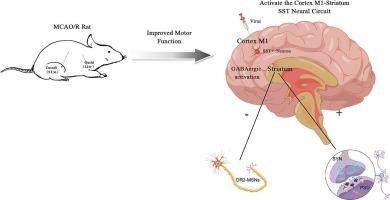电针通过皮层-纹状体生长抑素神经回路对大脑中动脉闭塞/再灌注大鼠运动功能障碍的影响。
IF 2.8
3区 医学
Q2 NEUROSCIENCES
引用次数: 0
摘要
缺血性卒中引起的运动功能障碍结果带来了巨大的健康负担和社会经济挑战。电针曲池穴(LI11)和足三里穴(ST36)对脑卒中后运动功能障碍有积极疗效。考虑到已有报道的GABAergic系统在运动中的功能,本研究旨在探讨EA对运动调节的详细机制,重点关注GABAergic系统的神经组织学和化学变化。结果表明,在LI11和ST36处EA可改善MCAO/R大鼠的改良神经严重程度评分(mNNS)评分和运动功能。LI11和ST36处的EA也通过GABA相关受体和GABA中间神经元的表达促进γ-氨基丁酸能(GABAergic)系统。本研究中,我们鉴定了远端突起的GABAergic中间神经元,根据其表达的分子标记可将其分为不同的亚型:Parvalbumin (PV+), Somatostatin (SST+)和Vasoactive Intestinal Peptide (VIP+)。此外,光遗传刺激这些突起神经元可以改善MCAO/R大鼠的运动功能障碍。值得注意的是,皮层m1 -纹状体(CS)-SST神经回路在EA干预下的运动改善中发挥了不可描述的作用。中等棘神经元II型多巴胺受体(DR2-MSNs)的下调以及突触素(SYN)和突触后密度-95 (PSD95)的上调表明,MSNs和突触可塑性可能是EA治疗LI11和ST36的下游机制。综上所述,在LI11和ST36处EA可通过CS-SST神经回路靶向调控下调的DR2-MSNs神经元,从而促进突触可塑性,改善运动功能。本文章由计算机程序翻译,如有差异,请以英文原文为准。

Effect of electro-acupuncture on motor dysfunction in middle cerebral artery occlusion/reperfusion rats though cortex-striatum somatostatin neural circuit
Ischemic stroke caused motor dysfunction results poses substantial health burdens and socioeconomic challenges. Electro-acupuncture (EA) at the acupoints of Quchi (LI11) and Zusanli (ST36) has shown positive efficacy in motor dysfunction after stroke. Considering the reported functions of the GABAergic system in locomotion, the present study aims to investigate the detailed mechanism of EA effects on motor regulation, focusing on the neural histological and chemical changes in the GABAergic system. Results demonstrated that EA at LI11 and ST36 improved the modified neurological severity score (mNNS) score and motor function of MCAO/R rats. EA at LI11 and ST36 also prompted γ-aminobutyric acid-ergic (GABAergic) system by the expression of GABA related receptors and GABA interneurons. Here, We have identified long-range projecting GABAergic interneurons, which can be classified into different subtypes based on the molecular markers they express: Parvalbumin (PV+), Somatostatin (SST+), and Vasoactive Intestinal Peptide (VIP+). Additionally, optogenetic stimulation of this projecting neurons can improve the motor dysfunction of MCAO/R rats. Notably, cortex M1-striatum (CS)-SST neural circuit which showed an indescribable role in locomotion improvement under EA intervention. The downregulation of the type II dopamine receptor in medium-sized spiny neurons (DR2-MSNs) and the upregulation of Synaptophysin (SYN) and Postsynaptic Density-95 (PSD95) suggest that MSNs and synaptic plasticity might be the downstream mechanisms of EA treatment at LI11 and ST36. To conclude, EA at LI11 and ST36 can promote synaptic plasticity and improve motor function by targeting and regulate downregulated DR2-MSNs neurons through the CS-SST neural circuit.
求助全文
通过发布文献求助,成功后即可免费获取论文全文。
去求助
来源期刊

Neuroscience
医学-神经科学
CiteScore
6.20
自引率
0.00%
发文量
394
审稿时长
52 days
期刊介绍:
Neuroscience publishes papers describing the results of original research on any aspect of the scientific study of the nervous system. Any paper, however short, will be considered for publication provided that it reports significant, new and carefully confirmed findings with full experimental details.
 求助内容:
求助内容: 应助结果提醒方式:
应助结果提醒方式:


